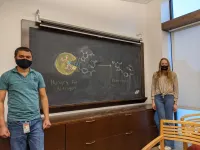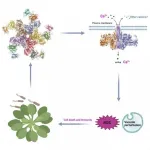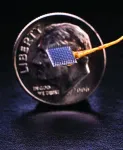INFORMATION:
At the beginning of 2021, Yizhar's optogenetic research was included in Nature's list of "Seven technologies to watch in 2021."
Prof. Ofer Yizhar is the incumbent of the Joseph and Wolf Lebovic Charitable Foundation Chair for Research in Neuroscience.
Prof. Yizhar's research is supported by the Ilse Katz Institute for Material Sciences and Magnetic Resonance Research; and the Adelis Brain Research Award.
Brain research gets a boost from mosquitos
New versions of light-sensitive proteins could illuminate the dark corners of our brain's communication pathways
2021-05-12
(Press-News.org) Can a protein found in a mosquito lead to a better understanding of the workings of our own brains? Prof. Ofer Yizhar and his team in the Weizmann Institute of Science's Neurobiology Department took a light-sensitive protein derived from mosquitos and used it to devise an improved method for investigating the messages that are passed from neuron to neuron in the brains of mice. This method, reported today in Neuron, could potentially help scientists solve age-old cerebral mysteries that could pave the way for new and improved therapies to treat neurological and psychiatric conditions.
Yizhar and his lab team develop so-called optogenetic methods - research techniques that allow them to "reverse engineer" the activity of specific brain circuits in order to better understand their function. Optogenetics uses proteins known as rhodopsins to control the activity of neurons in the mouse brain. Rhodopsins are light-sensing proteins - they are most known for their role in organs like the retina rather than in the dark inner reaches of the body. But the rhodopsins in the brains of Yizhar's mice enable him to control the activity of specific neurons when he and his team shine a minuscule beam of light into the mouse's brain. He is especially interested in communication between neurons: What signals are getting passed through the synapses, those gaps over which the brain's signals move? "We can detect the presence of the various neurotransmitters, but different neurons 'read' those neurotransmitters differently," he says. "Optogenetics enables us to not only see the 'ink,' but really to decipher the 'message'."
While optogenetic methods have produced a number of breakthrough results in labs around the world in recent years, they can be a bit finicky. In particular, the rhodopsins used for optogenetic studies tend to be imperfect when it comes to controlling the activity of synapses, the tiny junctions between neurons.
Yizhar and a large team of his trainees, including Dr. Mathias Mahn, Dr. Inbar Saraf Sinik and Pritish Patil, believed they could create a better version of the rhodopsins than those currently available. "We decided to look around and see what natural solutions exist out there," says Yizhar. And nature, it turns out, contains a multitude of variations on the rhodopsin molecule - not only in animal eyes but also fish, insects, and even mammals carry them in various body parts; some possibly for regulating their circadian cycles, others for purposes as yet unknown. Thus, the team started out with a long list of potential rhodopsin proteins, and their first job involved assessing which ones were most likely to fill their experimental requirements, which primarily included light-gated proteins that are able to modulate synaptic activity. Eventually the researchers winnowed their list down to two - one taken from a pufferfish and one from a mosquito.
It was the mosquito rhodopsin that turned out to be the most suitable. To evaluate the efficacy of the new mosquito-derived tool, the researchers tested their method against a drug that is known to reduce the strength of the communication between neurons in the brain. They found that the interference was just as effective, and much more stable with the mosquito rhodopsin.
More than that: Unlike a conventional drug that affects numerous parts of the brain and is hard to control, the researchers found that since only neurons that produce the mosquito sensor are affected by the light, the modulatory effect on the brain's synapses can be precisely controlled in both space and time - just by switching the light on or off in specific brain regions. They then validated the utility of the new tool by using it to block the release of the neurotransmitter dopamine on one side of the brain only: Illuminating the hemisphere expressing the mosquito rhodopsin with green light led to a one-sided bias in the behavior of these mice. In other words, they had created a tool that was precise, selective, and controllable.
"One of the major advantages of the mosquito rhodopsin is that it's bistable - that is, it does not need refreshing - and it is potentially very specific, so that we can control just the precise synapses in which we are interested," says Yizhar. "This is a very exciting technology, since it will allow us to discover the roles of specific pathways in the brain in a way that was not possible before. We think this mosquito protein could open the way to developing a whole family of new optogenetic tools for use in neuroscience research." These scientific endeavors will receive a great boost within the framework of the new Institute for Brain and Neural Sciences - Weizmann Institute's flagship project that is expected to bring together leading research groups from various fields, which will join efforts to unfold the mysteries of the brain.
ELSE PRESS RELEASES FROM THIS DATE:
Fighting food insecurity by building better beans
2021-05-12
EAST LANSING, Mich. - As climate change threatens global food security, researchers at Michigan State University are building better beans crucial to human nutrition by tapping into the genetics of the more heat-resistant tepary bean.
The tepary bean (Phaseolus acutifolius A. Gray) is a sister of the common bean which includes kidney, pinto and navy beans. "The common bean is the number one source of protein and nutrients for many people living in Central America and Africa," said Robin Buell, a professor of plant biology in MSU's College of Natural Science and former director of the Plant Resilience Institute.
Her research on bean genetics was published May 11 in Nature Communications.
"Mother nature has already made plants that are adapted to different climates," ...
Building molecules like Tinkertoys? A breakthrough study may pave the way
2021-05-12
Molecules are the building blocks for our modern world, from phones to cars to Doritos. But coming up with new ones is still an incredibly costly and time-consuming process. A group of University of Chicago chemists wants to find a better way.
"If you look at a diagram of a molecule, it seems like you should be able to just snap them together like Tinkertoys, but you can't," said Asst. Prof. Mark Levin. "We'd like to change that."
Their new discovery, published May 12 in Nature, represents a first step towards that transformation: a way to easily cut nitrogen atoms from molecules.
Despite decades of experiments, chemistry remains an art in many ways because molecules are built in a long, iterative process: attaching ...
Scientists uncover how resistance proteins protect plants from pathogens
2021-05-12
In plants, disease resistance proteins serve as major immune receptors that sense pathogens and pests and trigger robust defense responses. Scientists previously found that one such disease resistance protein, ZAR1, is transformed into a highly ordered protein complex called a resistosome upon detection of invading pathogens, providing the first clue as to how plant disease resistance proteins work. Precisely how a resistosome activates plant defenses, however, has been unclear.
A joint team led by Profs. ZHOU Jianmin, CHEN Yuhang and HE Kangmin at the Institute of Genetics and Developmental Biology of the Chinese Academy of Sciences and Prof. CHAI Jijie at Tsinghua University recently employed state-of-the-art electrophysiology and single-molecule imaging to investigate the molecular ...
Brain computer interface turns mental handwriting into text on screen
2021-05-12
Scientists are exploring a number of ways for people with disabilities to communicate with their thoughts. The newest and fastest turns back to a vintage means for expressing oneself: handwriting.
For the first time, researchers have deciphered the brain activity associated with trying to write letters by hand. Working with a participant with paralysis who has sensors implanted in his brain, the team used an algorithm to identify letters as he attempted to write them. Then, the system displayed the text on a screen - in real time.
The innovation could, with further development, let people with paralysis rapidly ...
Brain-computer interface creates text by decoding brain signals associated with handwriting
2021-05-12
PROVIDENCE, R.I. [Brown University] -- Researchers with the BrainGate collaboration have, for the first time, used an implanted sensor to record the brain signals associated with handwriting, and used those signals to create text on a computer in real time.
In a study published in the journal Nature, a clinical trial participant with cervical spinal cord injury used the system to "type" words on a computer at a rate of 90 characters per minute, more than double the previous record for typing with a brain-computer interface. This was done by the participant merely thinking about the hand motions involved in creating written letters.
The research team is hopeful that such a system could one day help to restore ...
Study reveals structure of key receptors involved in memory and learning
2021-05-12
Scientists have for the first time revealed the structure surrounding important receptors in the brain's hippocampus, the seat of memory and learning.
The study, carried out at Oregon Health & Science University, published today in the journal Nature.
The new study focuses on the organization and function of glutamate receptors, a type of neurotransmitter receptor involved in sensing signals between nerve cells in the hippocampus region of the brain. The study reveals the molecular structure of three major complexes of glutamate receptors in the hippocampus.
The findings may be immediately useful in drug development for conditions such as epilepsy, said senior author Eric Gouaux, Ph.D., senior scientist in the OHSU Vollum Institute, ...
Stanford scientists' software turns 'mental handwriting' into on-screen words, sentences
2021-05-12
Stanford scientists' software turns 'mental handwriting' into on-screen words, sentences
Call it "mindwriting."
The combination of mental effort and state-of-the-art technology have allowed a man with immobilized limbs to communicate by text at speeds rivaling those achieved by his able-bodied peers texting on a smartphone.
Stanford University investigators have coupled artificial-intelligence software with a device, called a brain-computer interface, implanted in the brain of a man with full-body paralysis. The software was able to decode information from the BCI to quickly convert the man's thoughts about handwriting into text on a computer screen.
The man was able to write ...
Drug overdose deaths before, after shelter-in-place orders during COVID-19 pandemic in San Francisco
2021-05-12
What The Study Did: Researchers describe overdose deaths in San Francisco before and after the initial COVID-19 shelter-in-place order to try to make clear whether characteristics of fatal overdoses changed during this time in an effort to guide future prevention efforts.
Authors: Luke N. Rodda, Ph.D., of the Office of the Chief Medical Examiner for the city and county of San Francisco, is the corresponding author.
To access the embargoed study: Visit our For The Media website at this link https://media.jamanetwork.com/
(doi:10.1001/jamanetworkopen.2021.10452)
Editor's Note: The article includes conflict of interest and funding/support disclosures. Please see the article for additional information, including other authors, ...
Perinatal outcomes during COVID-19 pandemic in Ontario, Canada
2021-05-12
What The Study Did: Rates of preterm birth and stillbirth in Ontario, Canada, during the first six months of the COVID-19 pandemic are evaluated in this study.
Authors: Andrea N. Simpson, M.D., M.Sc., of St Michael's Hospital, Unity Health Toronto, in Toronto, is the corresponding author.
To access the embargoed study: Visit our For The Media website at this link https://media.jamanetwork.com/
(doi:10.1001/jamanetworkopen.2021.10104)
Editor's Note: The article includes funding/support disclosures. Please see the article for additional information, including other authors, author contributions and affiliations, conflict of interest and financial disclosures, and funding and support.
INFORMATION:
Media advisory: The full study is linked to this news release.
Embed this ...
Violence-related medical treatment among US children, adolescents
2021-05-12
What The Study Did: This survey study estimated the number of children and adolescents in the United States who have received medical care as a result of assault, abuse or exposure to violence.
Authors: David Finkelhor, Ph.D., of the University of New Hampshire in Durham, is the corresponding author.
To access the embargoed study: Visit our For The Media website at this link https://media.jamanetwork.com/
(doi:10.1001/jamanetworkopen.2021.9250)
Editor's Note: The article includes conflict of interest and funding/support disclosures. Please see the article for additional information, including other authors, author contributions and affiliations, conflict of interest and ...
LAST 30 PRESS RELEASES:
Interaction of climate change and human activity and its impact on plant diversity in Qinghai-Tibet plateau
From addressing uncertainty to national strategy: an interpretation of Professor Lim Siong Guan’s views
Clinical trials on AI language model use in digestive healthcare
Scientists improve robotic visual–inertial trajectory localization accuracy using cross-modal interaction and selection techniques
Correlation between cancer cachexia and immune-related adverse events in HCC
Human adipose tissue: a new source for functional organoids
Metro lines double as freight highways during off-peak hours, Beijing study shows
Biomedical functions and applications of nanomaterials in tumor diagnosis and treatment: perspectives from ophthalmic oncology
3D imaging unveils how passivation improves perovskite solar cell performance
Enriching framework Al sites in 8-membered rings of Cu-SSZ-39 zeolite to enhance low-temperature ammonia selective catalytic reduction performance
AI-powered RNA drug development: a new frontier in therapeutics
Decoupling the HOR enhancement on PtRu: Dynamically matching interfacial water to reaction coordinates
Sulfur isn’t poisonous when it synergistically acts with phosphine in olefins hydroformylation
URI researchers uncover molecular mechanisms behind speciation in corals
Chitin based carbon aerogel offers a cleaner way to store thermal energy
Tracing hidden sources of nitrate pollution in rapidly changing rural urban landscapes
Viruses on plastic pollution may quietly accelerate the spread of antibiotic resistance
Three UH Rainbow Babies & Children’s faculty elected to prestigious American Pediatric Society
Tunnel resilience models unveiled to aid post-earthquake recovery
Satellite communication systems: the future of 5G/6G connectivity
Space computing power networks: a new frontier for satellite technologies
Experiments advance potential of protein that makes hydrogen sulfide as a therapeutic target for Alzheimer’s disease
Examining private equity’s role in fertility care
Current Molecular Pharmacology achieves a landmark: real-time CiteScore advances to 7.2
Skeletal muscle epigenetic clocks developed using postmortem tissue from an Asian population
Estimating unemployment rates with social media data
Climate policies can backfire by eroding “green” values, study finds
Too much screen time too soon? A*STAR study links infant screen exposure to brain changes and teen anxiety
Global psychiatry mourns Professor Dan Stein, visionary who transformed mental health science across Africa and beyond
KIST develops eco-friendly palladium recovery technology to safeguard resource security
[Press-News.org] Brain research gets a boost from mosquitosNew versions of light-sensitive proteins could illuminate the dark corners of our brain's communication pathways


